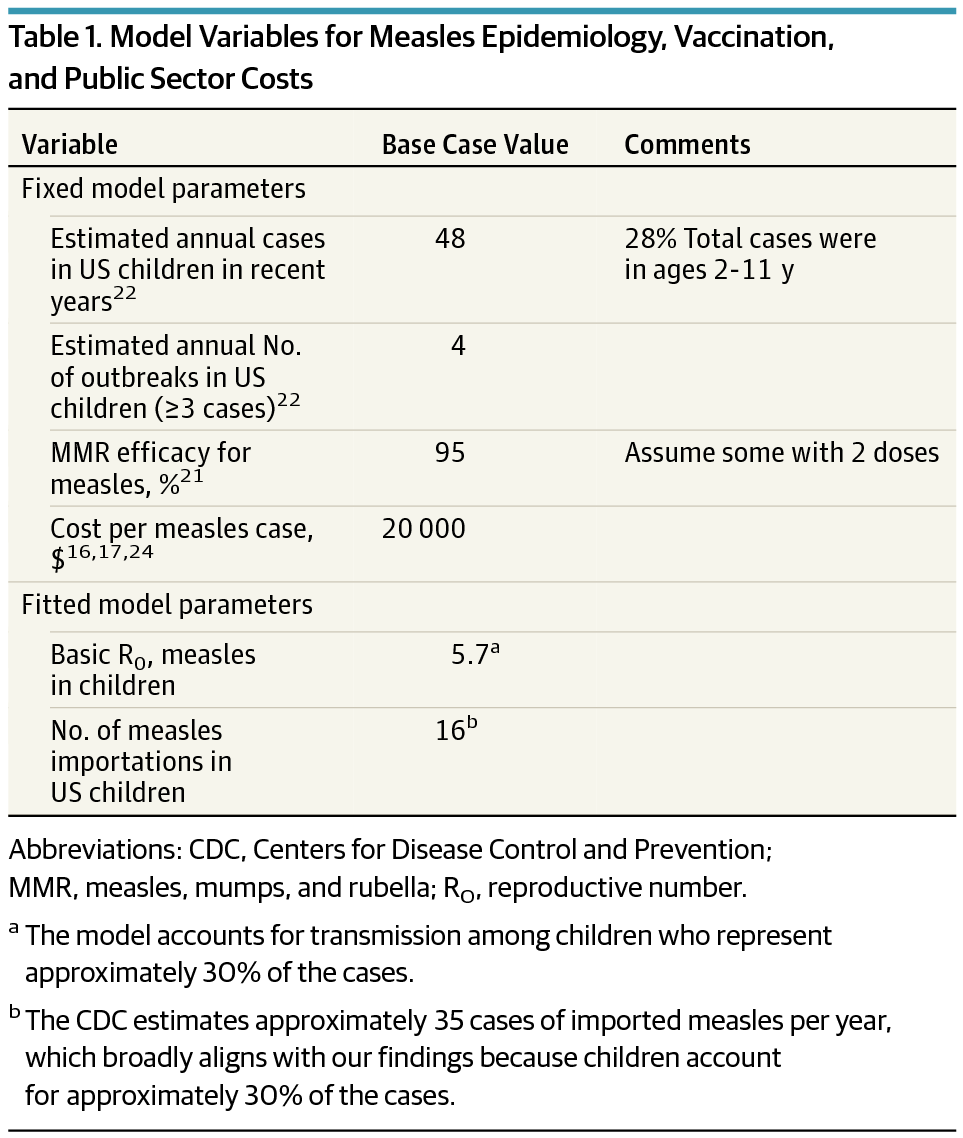当前位置:
X-MOL 学术
›
JAMA Pediatr.
›
论文详情
Our official English website, www.x-mol.net, welcomes your
feedback! (Note: you will need to create a separate account there.)
Public Health and Economic Consequences of Vaccine Hesitancy for Measles in the United States
JAMA Pediatrics ( IF 24.7 ) Pub Date : 2017-09-01 , DOI: 10.1001/jamapediatrics.2017.1695 Nathan C. Lo 1 , Peter J. Hotez 2
JAMA Pediatrics ( IF 24.7 ) Pub Date : 2017-09-01 , DOI: 10.1001/jamapediatrics.2017.1695 Nathan C. Lo 1 , Peter J. Hotez 2
Affiliation

|
Importance Routine childhood vaccination is declining in some regions of the United States due to vaccine hesitancy, which risks the resurgence of many infectious diseases with public health and economic consequences. There are ongoing policy debates on the state and national level, including legislation around nonmedical (personal-belief) exemptions for childhood vaccination and possibly a special government commission on vaccine safety, which may affect vaccine coverage. Objective To estimate the number of measles cases in US children and the associated economic costs under scenarios of different levels of vaccine hesitancy, using the case example of measles, mumps, and rubella (MMR) vaccination and measles. Design, Setting, and Participants Publicly available data from the US Centers for Disease Control and Prevention were used to simulate county-level MMR vaccination coverage in children (age 2-11 years) in the United States. A stochastic mathematical model was adapted for infectious disease transmission that estimated a distribution for outbreak size as it relates to vaccine coverage. Economic costs per measles case were obtained from the literature. The predicted effects of increasing the prevalence of vaccine hesitancy as well as the removal of nonmedical exemptions were estimated. The model was calibrated to annual measles cases in US children over recent years, and the model prediction was validated using an independent data set from England and Wales. Main Outcomes and Measures Annual measles cases in the United States and the associated public sector costs. Results A 5% decline in MMR vaccine coverage in the United States would result in an estimated 3-fold increase in measles cases for children aged 2 to 11 years nationally every year, with an additional $2.1 million in public sector costs. The numbers would be substantially higher if unvaccinated infants, adolescents, and adult populations were also considered. There was variation around these estimates due to the stochastic elements of measles importation and sensitivity of some model inputs, although the trend was robust. Conclusions and Relevance This analysis predicts that even minor reductions in childhood vaccination, driven by vaccine hesitancy (nonmedical and personal belief exemptions), will have substantial public health and economic consequences. The results support an urgent need to address vaccine hesitancy in policy dialogues at the state and national level, with consideration of removing personal belief exemptions of childhood vaccination.
中文翻译:

美国麻疹疫苗犹豫不决的公共卫生和经济后果
重要性 由于疫苗犹豫不决,美国某些地区的常规儿童疫苗接种率正在下降,这可能会导致许多传染病卷土重来,从而造成公共卫生和经济后果。州和国家层面正在进行政策辩论,包括关于儿童疫苗接种的非医疗(个人信仰)豁免的立法,以及可能会影响疫苗覆盖率的疫苗安全特别政府委员会。目的 以麻疹、腮腺炎和风疹 (MMR) 疫苗接种和麻疹为例,估计美国儿童麻疹病例数和在不同疫苗犹豫程度情况下的相关经济成本。设计,设置,和参与者 美国疾病控制和预防中心的公开数据用于模拟美国儿童(2-11 岁)的县级 MMR 疫苗接种覆盖率。随机数学模型适用于传染病传播,该模型估计了与疫苗覆盖率相关的暴发规模分布。每个麻疹病例的经济成本是从文献中获得的。估计了增加疫苗犹豫流行率以及取消非医疗豁免的预期影响。该模型针对近年来美国儿童的年度麻疹病例进行了校准,并使用来自英格兰和威尔士的独立数据集验证了模型预测。主要结果和措施 美国每年的麻疹病例数和相关的公共部门成本。结果 美国 MMR 疫苗覆盖率下降 5% 将导致全国 2 至 11 岁儿童的麻疹病例估计每年增加 3 倍,公共部门成本额外增加 210 万美元。如果还考虑未接种疫苗的婴儿、青少年和成年人群,这个数字会高得多。由于麻疹输入的随机因素和某些模型输入的敏感性,这些估计值存在差异,尽管趋势是稳健的。结论和相关性 该分析预测,即使是由于疫苗犹豫(非医学和个人信仰豁免)导致的儿童疫苗接种的微小减少,也会对公共健康和经济产生重大影响。
更新日期:2017-09-01
中文翻译:

美国麻疹疫苗犹豫不决的公共卫生和经济后果
重要性 由于疫苗犹豫不决,美国某些地区的常规儿童疫苗接种率正在下降,这可能会导致许多传染病卷土重来,从而造成公共卫生和经济后果。州和国家层面正在进行政策辩论,包括关于儿童疫苗接种的非医疗(个人信仰)豁免的立法,以及可能会影响疫苗覆盖率的疫苗安全特别政府委员会。目的 以麻疹、腮腺炎和风疹 (MMR) 疫苗接种和麻疹为例,估计美国儿童麻疹病例数和在不同疫苗犹豫程度情况下的相关经济成本。设计,设置,和参与者 美国疾病控制和预防中心的公开数据用于模拟美国儿童(2-11 岁)的县级 MMR 疫苗接种覆盖率。随机数学模型适用于传染病传播,该模型估计了与疫苗覆盖率相关的暴发规模分布。每个麻疹病例的经济成本是从文献中获得的。估计了增加疫苗犹豫流行率以及取消非医疗豁免的预期影响。该模型针对近年来美国儿童的年度麻疹病例进行了校准,并使用来自英格兰和威尔士的独立数据集验证了模型预测。主要结果和措施 美国每年的麻疹病例数和相关的公共部门成本。结果 美国 MMR 疫苗覆盖率下降 5% 将导致全国 2 至 11 岁儿童的麻疹病例估计每年增加 3 倍,公共部门成本额外增加 210 万美元。如果还考虑未接种疫苗的婴儿、青少年和成年人群,这个数字会高得多。由于麻疹输入的随机因素和某些模型输入的敏感性,这些估计值存在差异,尽管趋势是稳健的。结论和相关性 该分析预测,即使是由于疫苗犹豫(非医学和个人信仰豁免)导致的儿童疫苗接种的微小减少,也会对公共健康和经济产生重大影响。











































 京公网安备 11010802027423号
京公网安备 11010802027423号